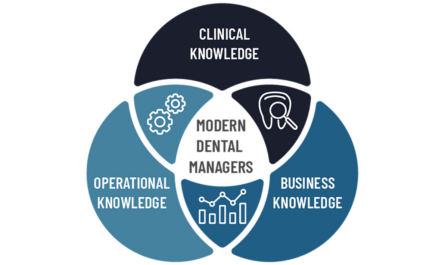Finding the right balance with compensations and expenses
By Heidi Arndt
Dental hygienist compensation remain a hot topic in dental groups and practices. The past 10 years have brought many changes to the dental hygiene landscape, with most regions experiencing a high volume of hygiene candidates, and few dental hygiene jobs available. Not only that, dental groups are continuously challenged by the decreasing insurance reimbursement, while still paying their staff at the same levels they were five years ago. So how do you find the right balance with compensation and expenses, all while keeping your staff happy?
The most common struggles dental groups deal with are:
- Paying more than they produce
- No real profit margin in hygiene
- Struggling with ‘dental hygiene compensation entitlement’
- There is no connection between hygiene pay and their performance
- Hygiene compensation has increased, while the industry standard of pay has decreased.
- Insurance reimbursement has decreased while hygiene salaries have increased.
There are many different variables that play out in dental groups across the country, and no one group is the same. With these variables, there is not one hygiene compensation method either. Compensation plans should be designed to fit within the needs of each individual dental group, understanding that salaries, demand, and insurance reimbursement are different in each group.
Beyond the typical hourly or daily pay rate, there are several different compensation models available, each with its advantages and disadvantages.
Here is a look at the three most common compensation structures that employs incentive pay as part of the overall structure.
Option No. 1: Current Base Compensation plus Incentive
This model can be effective when you are confident the dental hygienists will be participating in the incentive each and every month. If not, you will be taking a hit on your profit margin.
Here is how the plan is calculated:
Current hourly compensation x 3 = Target Hourly Revenue
Target Hourly Rate x Total Hours worked for past Month = Target Monthly Revenue
- When RDH produces over Monthly Target Revenue, they will get 10-30% of additional revenue.
Example:
Target Revenue is $27,000
Actual Revenue is $30,000
RDH gets 30% of $3,000
- Advantage: Easy to implement. No change to current compensation, just an option to help a dental hygiene team achieve an incentive.
- Disadvantage: It will not help your profit margin, unless everyone participates in the incentive.
Option No. 2: New Base Compensation plus Incentive
This model is one of the most common plans implemented today. It provides a “guarantee” to your hygiene team, and yet will motivate your hygiene team to take action by improving their performance.
Here is how the plan works:
You start by creating a new hourly rate for your entire hygiene team. This hourly rate should be set lower than the current average hourly rate of your dental group. You will want to find a balance with this rate, so your hygiene team does not feel insulted with the new hourly rate; yet they feel the need to improve their performance.
Once you have identified the new hourly/daily compensation, you will use the same calculation as above.
Example:
New hourly rate is $30 hour.
$30 x 3 = $90/hour target revenue
$90 target revenue x 180 hours = $16,200 is the new target monthly revenue
Anything over the $16,200 the RDH will get 25-30%.
- Advantage: Provides a guarantee for your dental hygiene team, while creating an incentive for them to improve performance in order for them to achieve their desired compensation level.
- Disadvantage: You will receive moderate push back from the hygiene team, as they will become really focused on the “decrease in pay.”
It may not help your profit margin, unless the majority of your hygiene team participates in the incentive. Modeling out this plan on a six-month review will be essential to the success of it.
Option No. 3: Percentage of Adjusted Gross Revenue
This compensation is one of the easiest to calculate, but one of the hardest for your hygiene team to accept. This plan will put your dental hygiene compensation at complete “risk.” The dental group must also investigate their state labor laws before implementation, as many states do require a guarantee pay for the dental hygienists.
Here is how the plan is calculated:
No target revenue with this option. The dental hygienist will simply make 28-33% of their Adjusted Gross Revenue.
- Advantage: This is the best and the easiest plan for controlling your profit margin through the ups and downs of revenue.
- Disadvantage: A difficult concept for the hygiene team to embrace.
No matter what option you choose, you need to model the plan out using your group’s hygiene financials, compensation and benefit data. The base pay and percentages will be different from group to group, so there is truly no “one size fits all” plan.
Questions to ask
Once you have a compensation plan identified, you will need to start working through the finite details of implementing the new hygiene compensation structure. Here are some of the questions you should ask yourself as you start to finalize the details of your hygiene compensation plan.
- Will the hygienist get paid for PTO, holiday and other tasks?
- Should we pay on Collection, Adjusted Gross Revenue or Gross Revenue?
- Will everyone’s base rate and percentage be the same?
- What happens when the hygiene team attends a Continuing Education meeting or a team meeting?
- What procedures do I get credit for?
- Will we give production credit for products we sell out of the practice?
- “We offer a free exam and X-rays to our new patients. How will this affect the hygiene team?”
- “Our doctors often offers discounted care to family and friends. How will this affect the hygiene team?”
- Will there be a merit increase?
- What if they work overtime?
Considerations
After implementing dental hygiene compensation structures for the past 12 years, the Enhanced Hygiene team has some additional advice for any group considering these changes.
- Create the plan that will get you to your profitability goal. Do not create an incremental plan, or a temporary plan to get your hygiene team to where they need to be. Create the “right” plan from the start. It is important to understand, that no matter what plan you put in place your hygiene team will likely get upset with the change. You do not want to go back and change the percentage or the plan after a few months or even one year after implementation.
- Be consistent with your team. Do not cut special deals with any certain team member. No matter the tenure of a team member, you need to have a compensation plan that fits everyone.
- Help your hygiene team understand how they can be successful on the plan using the protocols and systems your group has established.
- Before implementing a performance based compensation plan, your hygiene team should be tracking their numbers so they understand what revenue they bring in each day. This will help them better conceptualize the new compensation plan you are proposing.
- Provide mentoring and support the dental hygiene team before and during the implementation process. Compensation changes are not easy for anyone. The amount of support you provide will help ease the transition and support the hygiene team in meeting their own financial goals as well.
Implementing a new hygiene compensation structure is not an easy task, and will take the focus of your entire management team to make the transition as positive as possible. The dental hygiene team is an important part your dental group, so ensure you have empathy, support and follow up during this process. You want this change to be a win for your patients, your hygienists and the group.
If you have questions about implementing a new hygiene compensation structure, please contact Enhanced Hygiene at [email protected].






I agree…compensation should be related to production yet most offices go about it in a negative tone such as outlined in this article. Many dds and dh, do not conduct proper assessments for both caries and periodontal disease for which a dh is highly trained and capable of doing. Proper assessment with the development of a comprehensive tx plan presented to the patient with full explanation of benefits of tx and risks of not doing tx will increase not only production for the dds and the dh, but the overall health of the patient. Let’s not talk about compensation as though the dh is the anchor of the dental team sinking the success of the practice because of dh wages. If that is the case, then shame on all those involved. How about working as a team to develop and utilize our skills in an effort to boost morale and foster a positive and productive working environment for all. Patients do notice the difference. I hear it all the time.